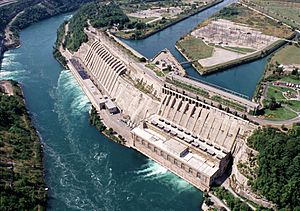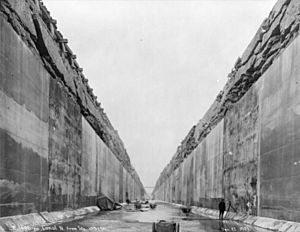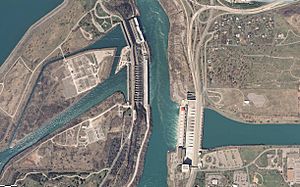Sir Adam Beck Hydroelectric Generating Stations facts for kids
The Sir Adam Beck Hydroelectric Generating Stations are two large power plants in Niagara Falls, Ontario, Canada. They are owned by Ontario Power Generation. These stations make electricity using the power of water. When the first station was built, it was the biggest hydroelectric plant in the world!
These stations take water from the Niagara and Welland rivers. They then release it back into the lower part of the Niagara River. Together, they can make almost 2000 megawatts (MW) of electricity. That's enough power for many, many homes!
Contents
Adam Beck I: The First Big Power Plant
Adam Beck I has 10 generators. It started making power in 1922. It was first called the Queenston-Chippawa Hydroelectric Plant. In 1950, it was renamed after Adam Beck. He was an important person who helped create public power in Ontario.
This station was the first very large project to make electricity from water in the world. Because of its importance, it was named a National Historic Site of Canada in 1990. Water for this station comes through the Chippawa-Queenston Power Canal from the Welland River.
Adam Beck II: A Newer, Stronger Station
Adam Beck II has 16 generators. It first started making power in 1954. Water for this station is brought from the Niagara River. It travels through two long tunnels that go under the city of Niagara Falls, Ontario. These tunnels start above the famous Niagara Falls.
A special reservoir was built for Adam Beck II. This reservoir can hold water that is diverted during the night. This stored water can then be used to make electricity during the day when more power is needed.
Improving Power Output
Between 2006 and 2013, Adam Beck II got a big upgrade. A new, large underground water tunnel was built. This project was called the Niagara Tunnel Project. The new tunnel helped the station make even more electricity. It made the best use of the Niagara River's water power.
The new tunnel is huge, about 12.7 meters (42 feet) wide and 10.2 kilometers (6.3 miles) long. It officially started working on March 21, 2013. This helped the power complex make an extra 150 MW of electricity. That's enough power for about 160,000 homes! In 2016, another big upgrade worth 60 million Canadian dollars began.
The 1965 Blackout
On November 9, 1965, a large power outage happened. It affected Ontario and several U.S. states. This happened because a protection device on one of the power lines from Adam Beck Station No. II was set incorrectly. This faulty device later caused a chain reaction that led to the big blackout. Over 30 million people were without power for up to 12 hours.
How Water is Used
The Chippawa-Queenston Power Canal is an open channel that brings water from the Welland River to the power stations. There are also three tunnel entrances upstream of the International Control Dam. These tunnels run under Niagara Falls, Ontario. They come out about 2 kilometers (1.2 miles) upstream of the Sir Adam Beck Generating Stations. One of these tunnels is hidden underwater, right in front of the Control Dam.
The open canal and the tunnel canal meet at a place called the "Cross Over." Here, there is a third channel that feeds a special pump generating station. This station can pump water up into the man-made reservoir at night. Then, during the day, it uses that stored water to make electricity. This water then flows back to the main Sir Adam Beck Generating Complex.
Controlling the Water Flow
The International Control Dam helps manage the water from the Niagara River. It is operated by Ontario Power Generation. This dam makes sure that water is shared fairly between the New York Power Authority and Ontario Power Generation. This is done according to the 1950 Niagara Treaty.
This treaty makes sure that a "curtain of water" always flows over Niagara Falls. During the day in tourist season (April 1 to October 31), 100,000 cubic feet per second (2,830 cubic meters per second) of water must flow over the falls. At night and during the off-tourist season, 50,000 cubic feet per second (1,415 cubic meters per second) must flow over the falls. The International Niagara Control Board watches over this treaty.





